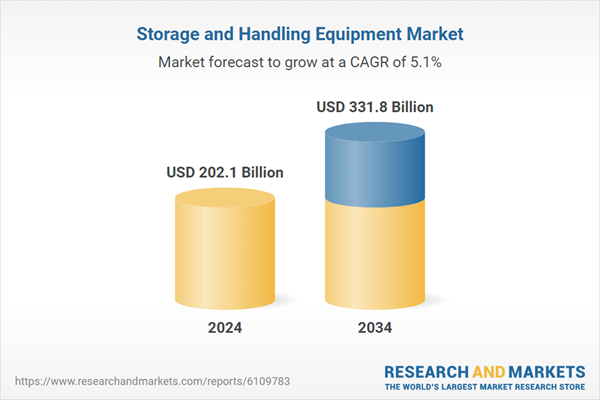The integration of robotics, automated storage and retrieval systems (AS/RS), conveyor systems, guided forklifts, and autonomous mobile robots (AMRs) is revolutionizing warehouse operations. These technologies enable businesses to efficiently handle increasing order demands without proportionally increasing labor expenses. By automating repetitive tasks and optimizing material flow, companies improve accuracy, speed, and throughput. Additionally, these innovations help reduce human error, enhance safety, and maximize space utilization within facilities. As a result, businesses can maintain high service levels and scalability, even during peak periods, while keeping operational costs in check. This shift toward automation is transforming warehousing into a smarter, more responsive component of the supply chain.
Storage equipment alone accounted for USD 140.2 billion in 2024 and is projected to reach USD 239.9 billion by 2034. Units like pallet racks, mezzanine platforms, and modular shelving are crucial for maximizing space utilization. With pallet racking holding more than half of this segment, demand is surging across industries from e-commerce to pharmaceuticals and food distribution, driven by the need for customizable solutions.
The semi-automatic segment captured a 33.2% share in 2024 and is expected to grow at 6.5% through 2034. Semi-automated solutions - such as guided forklifts, belt conveyors, and adjustable racks - hit the sweet spot by improving efficiency without the full investment of complete automation. Industry data indicates these systems are implemented in approximately 40% of mid-sized warehouses globally.
U.S. Storage and Handling Equipment Market was valued at USD 27.8 billion in 2024 and is anticipated to grow at a CAGR of 6.2% through 2034. The country’s extensive e-commerce infrastructure, dense distribution networks, and thriving industrial base - driven by logistics giants and retailers - continue to fuel investment in semi-automated conveyors, high-density racks, and next-gen robotics. Growth remains steady in both warehouse modernization and food-and-beverage logistics.
Key players in the Storage and Handling Equipment Market include Interroll Group, Dematic, Toyota Material Handling, Honeywell Intelligrated, Bastian Solutions, Hyster-Yale Materials Handling, Daifuku Co., Ltd., SSI Schäfer, Jungheinrich AG, Swisslog, Flexcon Container, Mecalux, BEUMER Group, Raymond Corporation, and Godrej Storage Solutions. Leading firms are focusing on modular and scalable systems that allow fast adaptation to varying inventory and seasonal peaks, targeting growth in e-commerce and retail sectors. They are integrating advanced technologies like IoT, AI-driven analytics, and robotics - especially AS/RS and AMRs - to enhance operational efficiency and reduce labor dependency.
Comprehensive Market Analysis and Forecast
- Industry trends, key growth drivers, challenges, future opportunities, and regulatory landscape
- Competitive landscape with Porter’s Five Forces and PESTEL analysis
- Market size, segmentation, and regional forecasts
- In-depth company profiles, business strategies, financial insights, and SWOT analysis
This product will be delivered within 2-4 business days.
Table of Contents
Companies Mentioned
- Bastian Solutions
- BEUMER Group
- Daifuku Co., Ltd.
- Dematic
- Flexcon Container
- Godrej Storage Solutions
- Honeywell Intelligrated
- Hyster-Yale Materials Handling, Inc.
- Interroll Group
- Jungheinrich AG
- Mecalux
- Raymond Corporation
- SSI Schäfer
- Swisslog
- Toyota Material Handling
Table Information
| Report Attribute | Details |
|---|---|
| No. of Pages | 200 |
| Published | June 2025 |
| Forecast Period | 2024 - 2034 |
| Estimated Market Value ( USD | $ 202.1 Billion |
| Forecasted Market Value ( USD | $ 331.8 Billion |
| Compound Annual Growth Rate | 5.1% |
| Regions Covered | Global |
| No. of Companies Mentioned | 15 |









